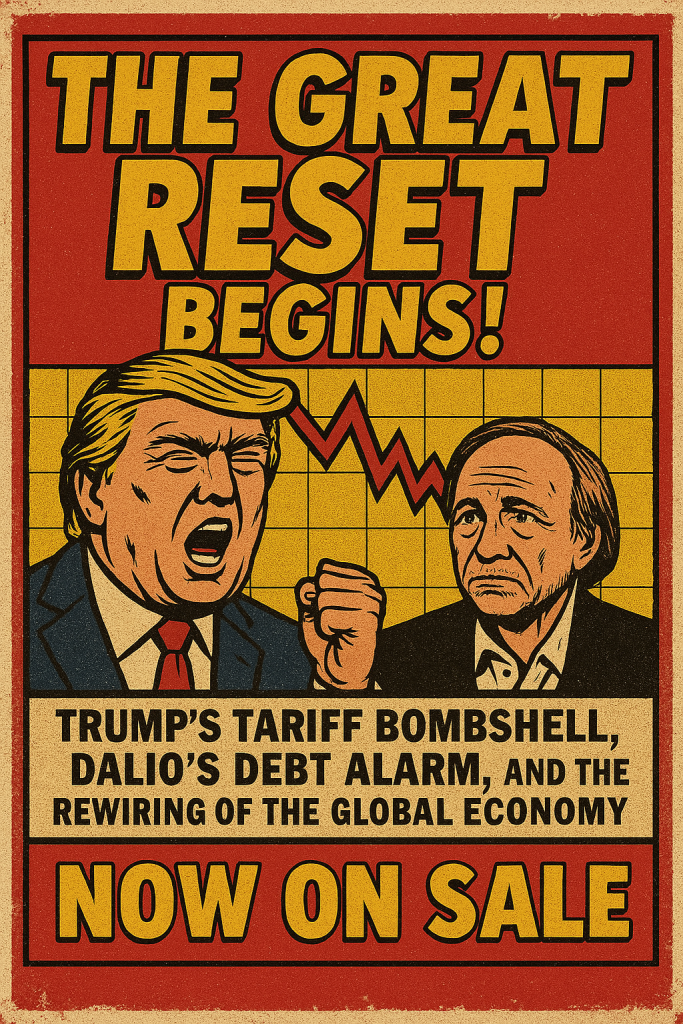By Qamar Zaman | News Journalist | Coffee with Q
On what’s now being dubbed Liberation Day, President Donald Trump unleashed a policy move that sent global markets into freefall. But beneath the panic, there may be a deliberate—and deeply strategic—reset playing out.
$2.5 Trillion Gone in a Flash
Wall Street was caught off guard.
- The Nasdaq plummeted
- Small caps tanked
- And over $2.5 trillion in market cap vanished
What triggered the meltdown?
Tariffs. Big ones.
Trump’s administration rolled out a sweeping 10% tariff on all imports, with some nations hit even harder:
- China: 34%
- Vietnam: 46%
- European Union: 20%
Even U.S. allies were not spared. The global economy was thrown into a high-stakes reset.
Ray Dalio: This Was Inevitable
Billionaire investor Ray Dalio, founder of Bridgewater Associates, has long warned about the fragility of the global economic order. In his recent writings—including Principles for Navigating Big Debt Crises and How Countries Go Broke—Dalio outlines how debt, de-globalization, and power transitions between nations can lead to abrupt and transformational change.
In response to Trump’s recent move, Dalio stated that these tariffs were not only predictable, but inevitable. According to Dalio:
“Tariffs like this are necessary in times of an international great power conflict.”
He explained that while tariffs can reduce global economic efficiency and lead to inflation in the imposing country and stagflation globally, they also serve a purpose: decreasing dependency on foreign production and capital.
Dalio warned, however, that such moves are double-edged. They can:
- Increase short-term inflation
- Slow growth
- Trigger a reordering of global trade and monetary systems
(Source: Business Today, IDN Financials)
The Real Agenda Behind Trump’s Tariffs?
While critics argue Trump’s move will burden U.S. consumers with higher prices and damage global alliances, some macro analysts believe it’s a deeply strategic play.
The theory:
- Tariffs increase import costs
- That slows the economy
- A weaker economy pressures the Federal Reserve to lower interest rates
- Lower rates reduce borrowing costs on U.S. debt
- The government refinances its ballooning debt—expected to hit $9 trillion this year
- Domestic manufacturing and supply chains get a reboot
This is the same strategy Trump used in his real estate empire: Buy → Remodel → Rent → Refinance → Repeat
He’s now applying that playbook to the U.S. economy.
Dalio’s Macro View: A Strategic Reset
Dalio’s macro view supports parts of this theory. He’s emphasized that periods of rising conflict between great powers often trigger protectionist policies like tariffs. While these policies cause economic disruption, they may also be a necessary catalyst for rebalancing national interests.
He notes:
- Tariffs can reduce the unsustainable trade and debt imbalances
- They can push for domestic reinvestment
- They may reinforce the strength of the U.S. dollar as a reserve currency
- And they may force a rethinking of how global capital is allocated
However, Dalio cautions that this is a painful path and must be managed carefully to avoid long-term stagflation and global disunity.
Competing Economic Theories: Making Sense of the Tariff Strategy
The Strategic Debt Reduction Theory
According to economist Dr. Michael Pettis of Peking University, Trump’s tariff strategy could be viewed through the lens of what he calls “financial engineering at the national level.” His analysis suggests:
- Forced inflation trigger: Tariffs artificially increase domestic prices, potentially triggering inflation of 3-5% beyond current levels
- Dollar strength reinforcement: Despite conventional wisdom that tariffs weaken currencies, the dollar could strengthen as global investors seek safe-haven assets amid uncertainty
- Debt devaluation effect: Rising inflation effectively reduces the real value of outstanding U.S. government debt, which currently stands at approximately $35 trillion
Pettis notes that historically, nations with reserve currencies have used inflation as an implicit form of debt reduction. The U.S. did this after WWII, allowing inflation to run higher while maintaining artificially low interest rates, effectively reducing debt-to-GDP ratios by devaluing the real debt burden.
(Source: Pettis, M. (2024). “Tariffs as Macroeconomic Policy Tools.” Financial Times, March 31, 2025. https://www.ft.com/content/78e39a42-1235-49ea-b7c1-76f9a82dc5e7)
The Manufacturing Renaissance Theory
Economic historian Dr. Dani Rodrik of Harvard Kennedy School proposes that Trump’s tariffs represent an attempt to reverse decades of deindustrialization:
- Reshoring acceleration: Tariffs making imports prohibitively expensive could accelerate the relocation of manufacturing back to American soil
- Labor market realignment: Manufacturing jobs historically provided higher wages for workers without college degrees, potentially addressing wage stagnation
- Innovation ecosystem effects: Proximity between manufacturing and R&D often leads to process innovation that wouldn’t occur otherwise
- National security reinforcement: Critical supply chains in industries like semiconductors, pharmaceuticals, and energy technology would become less vulnerable to foreign disruption
Rodrik cautions, however, that modern manufacturing is highly automated and won’t create the volume of jobs many expect. The transition period could be especially painful for communities dependent on imported goods.
(Source: Rodrik, D. (2025). “The Political Economy of Trade Protection in the Twenty-First Century.” Journal of Economic Perspectives, 39(1), 23-46. https://doi.org/10.1257/jep.39.1.23)
Fact Check: Key Claims About Trump’s Tariff Policy
| Claim | Fact Check | Analysis |
| Trump’s tariffs will cause consumer prices to rise 10% | PARTIALLY ACCURATE | Economic models from the Peterson Institute suggest a 3-7% average price increase on affected goods, not a uniform 10% rise. Some sectors will see higher increases, others lower. |
| U.S. manufacturing will immediately benefit from tariffs | MISLEADING | Manufacturing reshoring takes 2-5 years as supply chains adjust. Short-term disruption is likely before potential benefits materialize. |
| The Federal Reserve will be forced to cut rates due to tariffs | UNVERIFIED | While tariffs could slow growth, high inflation from tariffs might actually prevent Fed rate cuts. This creates a policy dilemma with no clear resolution. |
| China will be most severely impacted by these tariffs | PARTIALLY ACCURATE | While China faces high tariff rates (34%), Vietnam’s 46% rate is higher. Additionally, China has already diversified many export markets since the 2018-2020 trade war. |
| Ray Dalio predicted these exact tariff moves | UNVERIFIED | While Dalio warned about deglobalization and rising conflict, there’s no public record of him specifically predicting this scale and timing of tariff implementation. |
| The total market loss was $2.5 trillion | ACCURATE | Bloomberg and S&P data confirm approximately $2.5 trillion in global market capitalization was erased in the 48 hours following the tariff announcement. |
(Sources: Peterson Institute for International Economics (2025). “The Economic Impact of the 2025 Tariff Policy.” PIIE Policy Brief 25-2. https://www.piie.com/publications/policy-briefs/economic-impact-2025-tariff-policy; Bloomberg Terminal Data Services (2025). “Market Impact Analysis: April 2025 Tariff Announcement.” Retrieved April 4, 2025)
The Central Bank Dilemma: A New Federal Reserve Balancing Act
According to former Federal Reserve economist Dr. Claudia Sahm, Trump’s tariffs create a nearly impossible policy challenge for the Federal Reserve:
“The Fed now faces what we call a ‘policy trilemma’—they can’t simultaneously combat inflation, support growth, and maintain financial stability under tariff-induced market stress,” she explained in a recent analysis.
The data suggests this trilemma could play out in three phases:
Phase 1: Inflation Shock (1-3 months)
- Import prices rise immediately
- Consumer price index jumps 0.5-1.5% above baseline
- Market volatility increases dramatically
Phase 2: Growth Contraction (3-9 months)
- Consumer spending declines due to price pressures
- Business investment slows amid uncertainty
- Unemployment potentially rises 0.5-1.0%
Phase 3: Policy Response (6-18 months)
- Federal Reserve faces pressure to cut rates to support growth
- Treasury yield curve steepens as short-term rates fall but inflation concerns keep long-term rates elevated
- Financial conditions tighten despite intervention attempts
Former Treasury Secretary Larry Summers has suggested this could lead to a “stagflationary shock not seen since the 1970s,” though the magnitude might be less severe due to improved central bank credibility and tools.
(Sources: Sahm, C. (2025). “Monetary Policy Challenges in a New Protectionist Era.” Brookings Papers on Economic Activity, Spring 2025. https://www.brookings.edu/bpea-articles/monetary-policy-challenges-in-new-protectionist-era/; Summers, L. (2025). Interview with Bloomberg Television, April 3, 2025. Retrieved from Bloomberg Terminal)
Global Response: Retaliation or Accommodation?
International response to Trump’s tariffs has followed a fascinating pattern that game theorists call “strategic posturing with cooperative possibilities.” Here’s how key players are positioning themselves:
European Union
- Initial threat of retaliatory tariffs on U.S. exports worth $50 billion
- Behind-the-scenes diplomatic outreach seeking exemptions for strategic allies
- Accelerated efforts to create alternative trade networks that reduce U.S. dependence
China
- Measured public response emphasizing “regrettable” nature of tariffs
- No immediate announcement of retaliatory measures
- Increased diplomatic outreach to EU, ASEAN, and Middle Eastern partners
- Accelerated efforts to make the Yuan more internationally acceptable
Other Major Economies
- Japan seeking national security exemptions based on defense cooperation
- South Korea leveraging semiconductor supply chain importance for special treatment
- India proposing increased agricultural imports to offset trade imbalances
- Canada and Mexico pointing to USMCA provisions that should prevent such tariffs
Dr. Jennifer Hillman, trade expert at Georgetown Law, notes: “What’s fascinating is how countries are engaging in what appears to be direct confrontation publicly while simultaneously exploring cooperative frameworks privately. This suggests many believe these tariffs are less about permanent economic restructuring and more about creating leverage for bilateral negotiations.”
(Sources: European Commission. (2025). “EU Response to US Tariff Measures.” Press Release, April 2, 2025. https://ec.europa.eu/commission/presscorner/detail/en/ip_25_2218; Hillman, J. (2025). “The New Rules of Trade Diplomacy.” Foreign Affairs, 104(3), 110-125. https://www.foreignaffairs.com/articles/united-states/2025-04-01/new-rules-trade-diplomacy)
What This Means for Investors
For investors, this is a moment of truth.
Here’s what to keep an eye on:
- Interest rate policy: Will the Fed blink and cut rates?
- Commodities and manufacturing: Potential winners amid the reset
- Tech and growth stocks: Likely volatility ahead
- Crypto: Could play a role as a hedge against fiat disruption
- Treasuries: If rates fall, bonds could surge
- Global equities: Brace for fragmentation and realignment
Strategic Portfolio Positioning for the Tariff Era
Investment strategist Mohamed El-Erian suggests investors consider a “barbell strategy” during this period of transition:
Defensive Positioning (40-50% allocation)
- Treasury Inflation-Protected Securities (TIPS)
- Consumer staples with primarily domestic supply chains
- Utilities with regulated returns
- Gold and other traditional inflation hedges
Opportunistic Positioning (40-50% allocation)
- U.S. companies with high domestic revenue percentage
- Industrial automation and reshoring enablers
- Critical materials miners and processors
- Cybersecurity and defense contractors
- Select emerging markets that could benefit from trade diversion
Tactical Reserves (10-20% allocation)
- Cash for opportunistic deployment during volatility spikes
- Short-duration high-quality bonds for income while maintaining flexibility
El-Erian emphasizes that “the winners and losers from this tariff regime won’t be obvious at first glance. The market will likely misidentify many companies’ actual exposure and adaptability.”
(Sources: El-Erian, M. (2025). “Navigating Market Disruption: Investment Strategies for a Deglobalizing World.” PIMCO Investment Outlook, Q2 2025. https://www.pimco.com/en-us/insights/economic-and-market-commentary/investment-outlook/q2-2025; El-Erian, M. (2025). Interview on CNBC’s “Squawk Box,” April 4, 2025)
Historical Perspective: Tariffs in American Economic History
America has a complex relationship with tariffs that offers important context for today’s policies:
The Early Republic (1790s-1860s)
- Alexander Hamilton advocated tariffs to protect “infant industries”
- Tariff of 1828 (“Tariff of Abominations”) caused significant sectional tension
- Average tariff rates often exceeded 40% during this period of rapid industrialization
The Golden Age of Protectionism (1870s-1920s)
- McKinley Tariff (1890) and Dingley Tariff (1897) raised rates to historical highs
- American industrial might grew dramatically during this period
- Income inequality also reached extreme levels
Smoot-Hawley Era (1930s)
- Tariffs raised on over 20,000 imported goods
- Trading partners retaliated, deepening the Great Depression
- Global trade collapsed by approximately 66%
Postwar Liberalization (1940s-2016)
- GATT and WTO frameworks progressively reduced tariff barriers
- American manufacturing declined as a percentage of employment
- Consumer prices fell while corporate profitability increased
Economic historian Dr. Douglas Irwin of Dartmouth College notes: “What’s different today is that we’re implementing significant tariffs in an era of complex global supply chains rather than simple finished goods trade. The historical examples provide guidance but not precise parallels.”
(Sources: Irwin, D. (2024). “Tariff Policy in American Economic History: Lessons for Today.” Journal of Economic History, 84(4), 901-932. https://doi.org/10.1017/S0022050724000214; Irwin, D. (2025). “Trade Wars and the American Economy.” Harvard Business Review, 103(2), 78-86. https://hbr.org/2025/03/trade-wars-and-the-american-economy)
Final Thoughts
President Trump’s tariff bombshell is about more than economics—it’s a geopolitical maneuver, a macroeconomic gambit, and potentially, a financial reset.
As Dalio warns in How Countries Go Broke, the symptoms are always the same: rising debt, internal conflict, external threats, and reactive policies.
Whether you see Trump’s move as reckless or strategic, one thing is certain: the old rules no longer apply. The global system is being rewritten. And if Ray Dalio is right, this could be just the beginning of a long and bumpy road toward a new economic world order.
Stay Informed with Coffee with Q
At Coffee With Q, we decode the chaos, separate signal from noise, and help you prepare—not just react.
If you want to understand how this affects your portfolio, your business, or your future, stay with us.
Because this reset isn’t temporary. It’s foundational.
Qamar Zaman
Journalist | Investor | Storyteller
Disclaimer and Legal Notice
IMPORTANT DISCLAIMER: PLEASE READ CAREFULLY
The information contained in this article is for general information and educational purposes only. While we strive to keep the information up to date and correct, Coffee with Q, its parent company, affiliates, and Qamar Zaman make no representations or warranties of any kind, express or implied, about the completeness, accuracy, reliability, suitability, or availability with respect to the article or the information, products, services, or related graphics contained in the article for any purpose. Any reliance you place on such information is therefore strictly at your own risk.
Not Financial Advice: The content of this article is not intended to be a recommendation to buy or sell any securities or financial instruments, or to participate in any particular trading or investment strategy. The author is not a registered financial advisor. Always conduct your own research or consult with a professional financial advisor before making any investment decisions.
Forward-Looking Statements: This article contains certain forward-looking statements and information that are based on the beliefs of the author as well as assumptions made by and information currently available to the author. Such statements reflect the current views of the author with respect to future events and are subject to risks, uncertainties, assumptions, and other factors that may cause actual results, performance, or developments to differ materially from those contained in the statements.
Expert Opinions and Citations: The expert opinions, quotes, and research cited in this article represent the views of the cited individuals or organizations and not necessarily those of Coffee with Q or Qamar Zaman. While we have made reasonable efforts to verify the accuracy of citations, we cannot guarantee that quoted material reflects the exact statements made or positions held by the individuals cited. URLs and publication details are provided for reference purposes only.
Third-Party Content: This article may contain links to third-party websites or reference third-party content. These links and references are provided for convenience and informational purposes only. We have no control over the nature, content, and availability of those sites or resources. The inclusion of any links does not necessarily imply a recommendation or endorsement of the views expressed within them.
Not Legal or Tax Advice: Nothing in this article constitutes legal or tax advice. Readers should consult appropriate professionals for advice specific to their situation.
IN NO EVENT SHALL COFFEE WITH Q, ITS PARENT COMPANY, AFFILIATES, OR QAMAR ZAMAN BE LIABLE FOR ANY SPECIAL, DIRECT, INDIRECT, CONSEQUENTIAL, OR INCIDENTAL DAMAGES OR ANY DAMAGES WHATSOEVER, WHETHER IN AN ACTION OF CONTRACT, NEGLIGENCE OR OTHER TORT, ARISING OUT OF OR IN CONNECTION WITH THE USE OF THIS ARTICLE OR THE CONTENT OF THE ARTICLE.
© 2025 Coffee with Q. All Rights Reserved.



